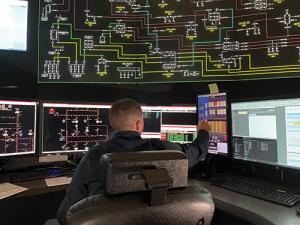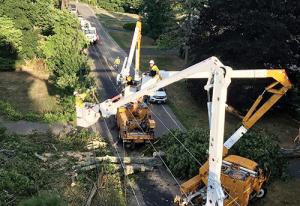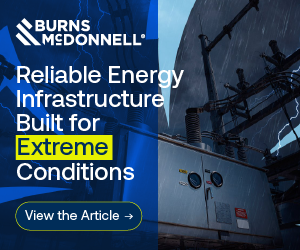COO of Eversource
Werner Schweiger is the COO of Eversource.
Committed to achieving carbon-neutral operations by 2030, Eversource, New England's largest energy provider, has some big projects on the horizon. As the energy provider to more than 4.3 million electric and natural gas customers in Connecticut, Massachusetts, and New Hampshire, the company is also investing in innovations and new technologies to make its infrastructure more resilient in light of the growing number of severe storms.

PUF's Steve Mitnick and I spoke with Werner Schweiger, Executive Vice President and Chief Operating Officer of Eversource, about the challenges facing the energy industry and his company's vision to tackle them in 2022 and beyond. What will success look like for energy providers when the road that lies ahead is yet untraveled?
— Michelle Fay, Partner, Guidehouse
Guidehouse's Michelle Fay: Share your view on what's in store for the new year, both for Eversource as well as for the industry in general?
Werner Schweiger: I'll give you a couple of specific examples that speak to Eversource, and then some that are more regional or industrywide. For us, it should be an exciting first quarter.
 Eastern Massachusetts Transmission Control Room.
Eastern Massachusetts Transmission Control Room.
We will begin construction of our first offshore wind project. We have a 50/50 joint venture with Ørsted, a global leader in off-shore wind or OSW. It's a venture that focuses on developing a four thousand megawatt wind field just east of Massachusetts.
Right now, about half of the wind field is subscribed and that entails three projects. South Fork Wind project, which started construction in February. The second is called Sunrise Wind. Both are on Long Island and will interconnect with the Long Island Power Authority system. The third is Revolution Wind, which is in Rhode Island and ties into the NGRID system.
The one we're excited about — the first that has cleared the permitting process — is South Fork Wind. It will come ashore in the East Hampton area, on the South Fork of Long Island. It's one hundred thirty megawatts and the smallest of the portfolio. Revolution Wind is seven hundred megawatts, and Sunrise Wind is nine hundred megawatts.
Regarding the South Fork Wind project, our portion entails the land-based infrastructure, while Ørsted is responsible for the wind field itself and all associated infrastructure at sea. That project is scheduled for completion by the end of 2023. The other two projects are in active siting and permitting and follow in the 2024 timeframe.
 Eversource crews responding to one of the major storms in Simsbury, CT.
Eversource crews responding to one of the major storms in Simsbury, CT.
PUF's Steve Mitnick: There's a lot of work involved, and you have a partner. Talk about how difficult it is to bring a project like this to fruition.
Werner Schweiger: The line of demarcation between the two joint venture partners is where the one hundred thirty-eight kilovolts cable comes ashore. From that point on it's the installation of the transmission cable, which runs several miles through East Hampton and then interconnects at one of LIPA's substations. This project not only provides a renewable resource but also addresses a reliability need on the South Fork of Long Island.
At Eversource, large transmission development is part of our core business. This type of infrastructure development is much of what we do every day. We have the in-house talent to conduct the siting and permitting, engineering, and project management.
We conducted a competitive solicitation for the physical construction of the line and major substation components. That portion went very well, but again, we get a lot of practice every day and maintain strong vendor relationships. We remain confident in the current plan and ability to execute and deliver Long Island's first OSW supply.
PUF's Steve Mitnick: Eversource arose from the combination of NSTAR and Northeast Utilities, and Northeast Utilities had a great history in transmission development. That core specialty capability of your company is perhaps a natural extension.
Werner Schweiger: What you refer to took place in the nineties, and early 2000s. Northeast Utilities was a significant transmission developer in Connecticut. At the time, large portions of Connecticut experienced the need for reinforcement and new construction to address reliability as well as congestion pricing concerns.
NSTAR was less of an overhead transmission developer, as major load centers such as Boston are served by a robust three hundred forty-five/one hundred fifteen kilovolts underground transmission network. We have combined these overhead and underground competencies in our current transmission organization to help advance reliability, resiliency, electrification, and renewable policy, including those OSW projects we have discussed.
As an example, all these project wind interconnections and associated reinforcements will leverage a combination of underground and overhead transmission assets. East Hampton is perhaps the most line of sight and will be all underground with a relatively short distance before it interties with the LIPA system.
The second project on Long Island, called Sunrise Wind, is a much longer underground line. It comes ashore further west than East Hampton along William Floyd Parkway in Mastic Beach, and then ties into a station in the Holtsville area.
This project will be supplied by eighty-four, eleven-megawatt turbines and be interconnected via an offshore HVDC substation and eighteen miles of three hundred twenty direct current voltage cable before it interties with an inverter station and injects at one hundred thirty-eight kilovolts.
Our third project in Rhode Island is comprised of sixty-four turbines at eleven megawatts each and will entail two offshore substations and tie into the NGRID system. This project supply will be under contract to Rhode Island and Connecticut.
PUF's Steve Mitnick: Eversource has a lot going on that you want to accomplish in 2022. Give a flavor of some of the other big projects.
Werner Schweiger: Another exciting project that we are now completing is a storage project in Provincetown, located at the east end of Cape Cod. It is a portion of our system that is currently supplied radially, and it's always been an area that has been exposed to storm activity along the coast.
Due to its radial supply, population growth during the summer season and the increasing need to manage DER growth in Massachusetts, the deployment of a storage solution was ideal. As such, this project is a twenty-five megawatt application that interconnects at the distribution level and will establish a second back feed source from Provincetown.
As I mentioned, aside from the reliability benefit, the other project impact is to help us manage the DER impact, especially solar, that has been growing on the system. Southeast and western Massachusetts are by far the largest DER growth areas we have.
Across the Eversource system, there are already two gigawatts of DER interconnected, with another two gigawatts in the queue. This type of utility scale storage will allow us as the grid operator to better balance the more dynamic flows we are seeing on the distribution system.
Resiliency, reliability, enabling renewable energy, it's a nice, synergistic project. The project will be placed in service in the first quarter of 2022. It's got some interesting challenges for our engineers in terms of control and protection, and islanding schemes but we believe installations such as these will be key to furthering the growth of renewables, electrification of transportation and heating initiatives, and to do so reliably.
Another initiative driven in part by the influx of increasing amounts of DER, as well as the levels of automation that we have deployed such as SCADA and distribution automation, has prompted us to take a look at how we operate and manage the data generated by the system.
We have our own version of the duck curve, albeit more regionally than other portions of the country, but it has advanced our thinking on how we manage the increasingly dynamic nature of the system going forward. For example, putting in service DMS systems, dynamic volt var compensation, and being able to operate the system, given all the various diverse supplies and intermittencies.
For example, I started my career years ago in the control room environment. When you wrote a switching order, it could have run almost any time during the day. Now you have situations where a switching order that was valid perhaps at nine in the morning, may no longer be valid at seven p.m. due to changes in the solar contribution or other variable supplies and demands.
This has prompted an initiative called, the Control Room of the Future. What it attempts to maintain is a strong focus on those core functions within the control room environment, such as switching and tagging, emergent issues, planned switching, and effective dispatching, to name a few without distraction, due to the increased data generated by the more dynamic distribution system. These core functions will always demand the attention of the operator to preserve the integrity of the system and those employees working on the system.
But with the amount of automation and new system dynamics, the data stream into the control rooms is changing. So, we're creating a configuration to preserve the attention to detail for those core functions, but behind the curtain, so to speak, is another team of individuals who will monitor all of the analytics, all the data, so that what is put in front of the operators in the future is actionable information, not large volumes of data.
We're rolling that out in the three states. It's focused on maintaining the integrity of the core control room operation, but then complementing that with an engineering staff as the grid continuous to prepare for increased electrification, DER, EV demands, and a host of dynamic impacts.
Guidehouse's Michelle Fay: Major storms are happening more frequently, and the severity is greater than in the past. How are you anticipating these changes will prepare you for that as you move forward?
Werner Schweiger: That is a major focus for us at Eversource. First, we take full advantage of the automation as it gives us visibility into the grid. During storms, the fact that we are so automated helps us get an early indication of the degree of impact that a weather event has made.
Aside from visibility, it also enables auto restoration of undamaged assets reducing the customers experiencing a sustained interruption. This degree of SCADA, distribution automation, and various types of sensors are leveraged each day outside of storm periods and have greatly contributed to the first quartile reliability that our customers continue to experience.
We have, however, implemented over the last couple of years, a shift in the mechanical strength of the system as we change the type of poles and class size, changes in conductor size and type, selective undergrounding, etcetera. This focus on resiliency of the system will continue for years to come as the majority of our distribution infrastructure is overhead and in heavily treed areas.
On the topic of vegetation management, we continue to work cooperatively with the communities we serve in order to strike a better balance between resiliency and the strong desire of our customers to maintain the aesthetics that vegetation provides. This area is by far the greatest threat to reliability during storm periods, impacting the scale and duration of the event, as well as the increasing number of blocked roads, public safety, as well as homeowner damage reports.
Related to enhancing our storm response, we are piloting a number of applications utilizing artificial intelligence. Like most utilities, we accumulate a large volume of data. But to answer your question specifically regarding storms, one of the key objectives early in the storm is damage assessment.
It influences the number of resources you will need, and how long will it take to restore. We have pilots going on that look to speed up that process, using AI and vehicles that can drive the system quickly, capture the data, interpret that data, and get that data back for some early indication of how many poles are broken and how many wires are down.
Applications such as this, our existing automation, and some early success utilizing drones are intended to yield early information aiding in restoration but also providing information to our customers on the progress of the restoration.
We take advantage of each storm event on our system to apply any lessons learned and continue to raise the bar whether it is in the areas of logistics, communications or restoration. Organizations such as the AEIC have been invaluable in providing a forum for sharing of best practices in many areas, storm response being just one of those.
Guidehouse's Michelle Fay: As an Eversource customer, I appreciate those emails and text notifications, which tell me when my power's going to be restored.
Werner Schweiger: It's a frustrating customer experience when you have a big storm and experience an outage. We try as quickly as we can to provide you an early indication as to how long the restoration might be.
Is it a matter of hours or is it a matter of days, so you can make those life management decisions. The recent shift of more customers working remote from home has certainly placed an even greater sensitivity on timely communication and rapid restoration.
As the damage assessment increases in clarity and information regarding restoration, blocked roads, and critical facilities impacted is generated, then sharing that information with customers and communities takes many forms whether on-the-ground representatives, texts, emails, community portals or IVR calls. These are some of the examples you experienced firsthand.
It's a noticeable change in the last couple of years in terms of what's occurred with the weather severity, and we have discussed several initiatives that Eversource has undertaken to minimize the impact to our customers. We continue to work with all stakeholders to enhance every aspect of storm response including influencing areas such as vegetation clearances to avoid interruptions from occurring at all during storm and non-storm periods.
There's also selective undergrounding, and it's a very expensive alternative. When you look at our service area, you have forty thousand miles of overhead, and can't make a wholesale decision to underground everything. We do, however, believe a program of selective undergrounding is one of those items in the resiliency portfolio going forward.
PUF's Steve Mitnick: You have a substation near the water in Boston built maybe twenty or thirty feet above the ground to deal with flooding to be more resilient.
Werner Schweiger: The substation you are referring to is our Seafood Way site. This station is an elevated GIS station completed about ten years ago. It is an example of where we have incorporated weather related risks such as flooding into our designs. This area has undergone significant growth in recent years and this type design will help mitigate the exposure the area has to flooding generated by large storm events.
Guidehouse's Michelle Fay: If you were to look back a year from now and say, we accomplished what we thought we were going to accomplish, what does success look like at the end of next year?
Werner Schweiger: If I look back, I would say in the last two years, I am proud of our people in terms of how they adapted to the new environment we all are working through. We average over one hundred storms a year and our employees have stepped up every time.
We have had to adapt to various protocols for COVID, changes in PPE requirements, and work methods to name just a few. Although it's challenging for all of us to work through a COVID environment, our employees have worked through some tough times in all types of weather.
I would say, you can do a lot of things with technology such as those we have discussed, but the real enabler is your people, their passion, and the ability to execute. I anticipate that when we look back on 2022 and on some of the initiatives we have discussed, our employees will again be the key to those successes as we look for more innovative ways to serve our customers whether it's offshore wind, electrification, resiliency, or storm response.



